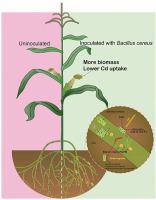Chemosphere ( IF 8.8 ) Pub Date : 2021-06-10 , DOI: 10.1016/j.chemosphere.2021.131095 Jun-Feng Wang 1 , Wan-Li Li 1 , Iftikhar Ahmad 2 , Bao-Yan He 1 , Li-Li Wang 1 , Tao He 1 , Fo-Peng Wang 1 , Zhi-Min Xu 1 , Qu-Sheng Li 1

|
Reducing cadmium (Cd) bioavailability and rhizobacterial Cd mobilization functions in the rhizosphere via the inoculation of screened microbial inoculum is an environmental-friendly strategy to improve safety of crop grains. In this study, Bacillus Cereus, a model Cd resistant strain, was selected to explore its effects on Cd bioavailability and uptake, bacterial metabolic functions related to Cd mobilization. Results indicated that inoculation of Bacillus Cereus in maize roots of sand pot with water-soluble Cd (0.06–0.15 mg/kg) and soil pot with high Cd-contaminated soil (total Cd: 2.33 mg/kg; Cd extracted by NH4NO3: 38.6 μg/kg) could decrease water-soluble Cd ion concentration by 7.7–30.1% and Cd extracted with NH4NO3 solution by 7.8–22.5%, inducing Cd concentrations in maize grains reduced by 10.6–39.9% and 17.4–38.6%, respectively. Even for a single inoculation in soil, Cd concentration in maize grains still satisfy food safety requirements (Cd content: 0.1 mg/kg dry weight) due to its successful colonization on root surface of maize. Bacillus Cereus could enrich more plant growth promotion bacteria (PGPB) and down-regulate the expression of genes related to bacterial motility, membrane transports, carbon and nitrogen metabolism in the rhizosphere soil, decreasing Cd bioavailability in soil. Approximately 80% Cd2+ in media was transferred into intracellular, meanwhile Cd salts (sulfide and/or phosphate) were produced in Bacillus Cereus through biomineralization process. Overall, this study could provide a feasible method for improving safety of maize grains via the inoculation of Bacillus Cereus under Cd pollution.
中文翻译:

蜡样芽孢杆菌对 Cd2+ 的生物矿化和抑制根际细菌 Cd 动员功能以提高玉米籽粒的安全性
通过接种经过筛选的微生物接种物来降低根际中镉 (Cd) 的生物利用度和根际细菌 Cd 动员功能,是提高作物谷物安全性的环境友好策略。在本研究中,选择蜡样芽孢杆菌(Bacillus Cereus),一种耐镉模型菌株,探索其对镉生物利用度和吸收的影响,以及与镉动员相关的细菌代谢功能。结果表明,在水溶性Cd(0.06-0.15 mg/kg)砂盆和高Cd污染土壤(总Cd:2.33 mg/kg;NH 4 NO提取的Cd)的玉米根中接种蜡样芽孢杆菌3 : 38.6 μg/kg) 可将水溶性 Cd 离子浓度降低 7.7–30.1%,并用 NH 4萃取 CdNO 3溶液减少 7.8-22.5%,导致玉米粒中 Cd 浓度分别降低 10.6-39.9% 和 17.4-38.6%。即使在土壤中单次接种,玉米籽粒中的 Cd 浓度仍然满足食品安全要求(Cd 含量:0.1 mg/kg 干重),因为它成功地定植在玉米根表面。蜡状芽孢杆菌可以富集更多的植物生长促进菌(PGPB),下调根际土壤中细菌运动、膜转运、碳氮代谢相关基因的表达,降低土壤中镉的生物有效性。培养基中大约 80% 的 Cd 2+被转移到细胞内,同时在蜡状芽孢杆菌中产生 Cd 盐(硫化物和/或磷酸盐)通过生物矿化过程。总体而言,本研究可为Cd污染下接种蜡样芽孢杆菌提高玉米籽粒安全性提供一种可行的方法。



























 京公网安备 11010802027423号
京公网安备 11010802027423号